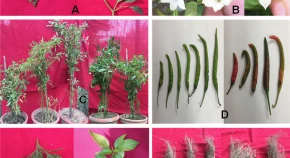Studies on qualitative and quantitative characters of mutagenised chili populations induced through MMS and EMS
Research Articles | Published: 02 November, 2020
First Page: 793
Last Page: 799
Views: 4202
Keywords: Capsicum annum L., Methylmethane sulphonate (MMS), Ethylmethane sulphonate (EMS), Induced mutagenesis, Quantitative traits, Qualitative traits
Abstract
Capsicum annum L. is the one of the economically important spice crop and has been in use from the ancient time for both food and medicinal purposes. The present investigation has been carried out to study the responses of C. annum, to the chemical mutagens MMS and EMS (0.1%, 0.25%, 0.50%, 0.75% and 1.0%). The qualitative and quantitative traits were observed from the seedling stage to maturity of chili plant, which includes plant height, leaf size and leaf shape, branch per plant, fruit size, number of pods per plants, weight of 1000 seeds in gram, yield per plant and root length. Statistical analysis of the traits showed the induction of significant variations at different concentrations of the mutagen treatments. Quantitative traits including plant height and yield per plant showed useful variations for further selection and advancement in the subsequent generations. The observed morphological variations provided valuable genetic resources which will be helpful in improving the agronomic characters through chili breeding program.

References
- Aguilar-Meléndez A, Morrell PL, Roose ML, Kim SC (2009) Genetic diversity and structure in semiwild and domesticated chiles (Capsicum annuum; Solanaceae) from Mexico. Am J Bot 96(6):1190–1202
- Ariraman M, Gnanamurthy S, Dhanavel D, Bharathi T, Murugan S (2014) Mutagenic effect on seed germination, seedling growth and seedling survival of Pigeon pea (Cajanus cajan (L.) Millsp). Int Lett Natl Sci 21:41–49
- Bonsu KO, Owusu EO, Nkansah GO, Oppong-Konadu E, Adu-Dapaah H (2003) Morphological characterisation of hot pepper (Capsicum sp.) Germplasm in Ghana. Ghana J Hortic 2:17–23
- Bosland PW, Votava E (2000) Peppers, vegetables and spices. CABI Publishing, New York ISBN-13: 9780851993355
- Bosland PW, Coon D, Reeves G (2012) ‘Trinidad Moruga Scorpion’ pepper is the world’s hottest measured chile pepper at more than two million Scoville Heat Units. HortTechnology 22:534–538
- Carrizo GC, Barfuss MH, Sehr EM, Barboza GE, Samuel R, Moscone EA, Ehrendorfer F (2016) Phylogenetic relationships, diversification and expansion of chili peppers (Capsicum, Solanaceae). Ann Bot 118(1):35–51
- Dale JW, Schanz M (2002) From genes to genomes, concept and applications of DNA technology. John Wiley and Sons, Amsterdam, p 360p
- Delatorre J, Pinto M, Cardemil L (2010) Effects of water stress and high temperature on photosynthetic rates of two species of Prosopis. J Photochem Photobiol B 92(2):67–76
- Eshbaugh WH (2012) The taxonomy of the genus Capsicum. In: Russo VM (ed) Peppers, botany production and uses. CABI, Wallingford, pp 14–28
- Grubben HG, Denton OA, Messiaen CM, Schippers RR, Lemaneus RH, Oyen LP (2004) Plant resources of tropical Africa 2. PROTA Foundation, Netherland, pp 27–29
- Ibiza VP, Blanca J, Cañizares J, Nuez F (2012) Taxonomy and genetic diversity of domesticated Capsicum species in the Andean region. Genet Resour Crop Evol 59(6):1077–1088
- Ince AG, Karaca M, Onus AN (2009) Development and utilization of diagnostic DAMD-PCR markers for Capsicum accessions. Genet Resour Crop Evol 56(2):211–221
- Ince AG, Karaca M, Onus AN (2010) Genetic relationships within and between Capsicum species. Biochem Genet 48:83–95
- Jyothi KU, Kumari SS, Ramana CV (2011) Variability studies in chilli (Capsicum annuum L.) with reference to yield attributes. J Hortic Sci 6(2):133–135
- Laskar RA, Khan S (2014) Mutagenic effects of MH and MMS on induction of variability in broad bean (Vicia faba L.). Ann Res Rev Biol 4:1129–1140
- Mansour-Gueddes SB, Tarchoun N, Teixeira da Silva JA, Saguem S (2010) Agronomic and chemical evaluation of seven hot pepper (Capsicum annuum L.) populations grown in an open field. Fruit Veg Cereal Sci Biotechnol 4:93–97
- Moscone EA, Scaldaferro MA, Grabiele M, Cecchini NM, Garcia YS, Jarret R, Daviña JR, Ducasse DA, Barboza GE, Ehrendorfer F (2007) The evolution of chili peppers (Capsicum - Solanaceae): a cytogenetic perspective. Acta Hortic 745:137–169
- North A, Pennanen J, Ovaskainen O, Laine AL (2011) Local adaptation in a changing world: the roles of gene-flow, mutation, and sexual reproduction. Evolution 65(1):79–89
- Obidiebube EA, Eruotor PG, Akparobi SO, Emosaariue SO, Achebe UA, Kator PE (2012) Response of four cultivars of pepper (Capsicum frutescens L.) to different levels of NPK fertilizer in rainforest agroecological zone. Int J Agric Sci 2(12):1143–1150
- Pandit MK, Adhikary S (2014) Variability and heritability estimates in some reproductive characters and yield in chilli and height (Capsicum annuum L.). Int J Plant Soil Sci 3(7):845–853
Author Information
Department of Botany, Aligarh Muslim University, Aligarh, India